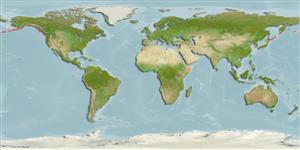Environment: milieu / climate zone / depth range / distribution range
Ökologie
seewasser demersal; tiefenbereich 0 - 12 m (Ref. 2850). Temperate; 66°N - 32°N
Eastern Pacific: Bering Sea coast of Alaska to southern California, USA.
Size / Gewicht / Alter
Maturity: Lm ? range ? - ? cm
Max length : 20.0 cm TL Männchen/unbestimmt; (Ref. 2850)
Kurzbeschreibung
Bestimmungsschlüssel | Morphologie | Morphometrie
Rückenflossenstacheln (insgesamt) : 69 - 78; Rückenflossenweichstrahlen (insgesamt) : 0; Afterflossenstacheln: 2 - 3; Afterflossenweichstrahlen: 40 - 50. Caudal rounded; pectorals very small (Ref. 6885). Olive green to olive dark brown dorsally, yellow to green ventrally, frequently with darker markings on side, small white spots sometimes evident along midside, 4 light and dark streaks reaching back and down from eyes, fins green to brown tinged with yellow (Ref. 6885).
Found under rocks in intertidal areas and to about 12 m depth (Ref. 2850). Feeds on crustaceans, and red and green algae (Ref. 6885).
Life cycle and mating behavior
Geschlechtsreife | Fortpflanzung | Ablaichen | Eier | Fecundity | Larven
Eschmeyer, W.N., E.S. Herald and H. Hammann, 1983. A field guide to Pacific coast fishes of North America. Boston (MA, USA): Houghton Mifflin Company. xii+336 p. (Ref. 2850)
IUCN Rote Liste Status (Ref. 130435: Version 2024-1)
Bedrohung für Menschen
Harmless
Nutzung durch Menschen
Tools
Zusatzinformationen
Download XML
Internet Quellen
Estimates based on models
Preferred temperature (Ref.
123201): 4.7 - 13, mean 8.2 °C (based on 581 cells).
Phylogenetic diversity index (Ref.
82804): PD
50 = 1.0000 [Uniqueness, from 0.5 = low to 2.0 = high].
Bayesian length-weight: a=0.00389 (0.00180 - 0.00842), b=3.12 (2.94 - 3.30), in cm total length, based on all LWR estimates for this body shape (Ref.
93245).
Trophic level (Ref.
69278): 2.6 ±0.20 se; based on food items.
Widerstandsfähigkeit (Ref.
120179): mittel, Verdopplung der Population dauert 1,4 - 4,4 Jahre. (Preliminary K or Fecundity.).
Fishing Vulnerability (Ref.
59153): Low vulnerability (10 of 100).
